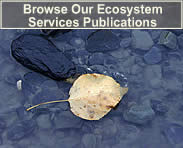
More About Ecosystem Services
Ecosystem Services are commonly defined as benefits people obtain from ecosystems. The Millennium Ecosystem Assessment – a four-year United Nations assessment of the condition and trends of the world’s ecosystems - categorizes ecosystem services as:
- Provisioning Services or the provision of food, fresh water, fuel, fiber, and other goods;
- Regulating Services such as climate, water, and disease regulation as well as pollination;
- Supporting Services such as soil formation and nutrient cycling; and
- Cultural Services such as educational, aesthetic, and cultural heritage values as well as recreation and tourism.
As population, income, and consumption levels increase, humans put more and more pressure on the natural environment to deliver these benefits. The 2005 Millennium Ecosystem Assessment, prepared by a group of over 1300 international experts, found that 60 percent of ecosystem services assessed globally are either degraded or being used unsustainably. Seventy percent of the regulating and cultural services evaluated in the assessment are in decline. Millennium Ecosystem Assessment scientists predicted that ecosystem degradation could grow significantly worse in the first half of the 21st century, with important consequences to human well-being.
Climate change, pollution, over-exploitation, and land-use change are some of the drivers of ecosystem loss, as well as resource challenges associated with globalization and urbanization. Land use change is an immediate issue in the United States. Today, the Nation is experiencing a loss of open space and a decline in forest health and biodiversity, particularly on private lands. Approximately 57% of all forestland in the United States, or 429 million acres, is privately owned. Non-industrial interests – families, organizations, and communities that own the land for the aesthetics and uses that forests provide or for income generated from the sale of forest products and services - own 85% of our private lands. Recent trends in parcelization and divestiture of private lands in the United States suggest that private landowners are commonly under economic pressures to sell their forest holdings. Rising property values, tax burdens, and global market competition are some of the factors that motivate landowners to sell their lands, often for development uses. The loss of healthy forests directly affects forest landowners, rural communities, and the economy. As private lands are developed, we also lose the life-supporting ecosystem services that forests provide.
Regulations, land acquisitions, conservation easements, and tax incentives are some of the conservation approaches that aim to protect and conserve the Nation’s forests and grasslands. Over the past decade, advances in sustainable forest management and forest certification have complemented conservation objectives. Traditional conservation programs, however, may not be enough to safeguard natural landscapes and biodiversity, and traditional markets may not provide landowners with a sufficient economic incentive to own and sustainably manage forestland. To reverse the loss and degradation of ecosystem services, economic and financial motivations must include a conservation objective, and the value of ecosystem services needs to be incorporated into any decision-making.
How can we make good stewardship profitable?
Mechanisms are needed by which private forest landowners can seek returns on their forestland in addition to those commonly associated with commercial forest products. The ability to capture the financial value of ecosystem services may help landowners who currently do not benefit from the true value of their land and all of the goods and services forests provide. Because ecosystem services are not traded and do not have a “price,” landowners are not typically compensated for the critical benefits forests naturally deliver to the public. New natural revenue streams might help forest owners cover the costs of owning forestland and provide them with incentives to hold onto their land and practice sustainable forest management. Valuing ecosystem services will encourage forest restoration and may provide a new means to finance reforestation and afforestation activities. Valuing forests as natural assets will increase society’s appreciation and support of lands that are already protected and healthy.
New approaches to conservation are emerging that may financially compensate landowners for providing ecosystem services. Markets and payments for carbon sequestration, watershed management, ecotourism, and a host of other services may supplement traditional forest revenues and promote good stewardship, especially when used together with other conservation tools.
Learn more…
Valuing Ecosystem Services: Capturing the true value of nature's capital, an overview (![]() PDF, 0.2 MB)
PDF, 0.2 MB)
Location: http://www.fs.fed.us/ecosystemservices/About_ES/index.shtml
Updated: June 3, 2008 10:50 AM


